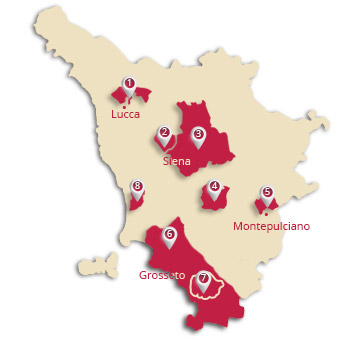Tuscany: the cradle of Chianti and Brunello di Montalcino

Our sommelier for Tuscany is Silvia Bertini
Silvia is Sommelier A.I.S. since 1999 , she has a degree in agriculture and she is enabled to the profession of agronomist.
Do you need more precise info about Tuscany ?
Questions, doubts, clarifications ?
Write Silvia at [email protected]
Of all the Italian wine regions, perhaps Tuscany has the most ancient traditions of all. The Etruscans began cultivating vineyards here in the 8th century B.C. They used live trees as supports for the vines: today in some areas of Tuscany we can still find traces of this "elevated" form of cultivation. However it was during the period of the Roman Empire that Tuscan wines won the fame that would endure through the centuries until modern times. Today Tuscan wines are known and loved throughout the world, just as the Tuscan countryside is. Tuscany, of all the Italian regions, has been able to happily balance tourism with oenologia, partially due to its spectacular landscape. Splendid hills covered with vineyards alternate with lanes of cypress and olive groves. Here, more than anywhere else, the winemakers have been able to protect the environment and make the most of their natural resources: we can find areas of magnicent natural beauty that have remained identical to when they were painted by maestro Lorenzetti in the13th century! Let's take a look at the principle zones.
We'll begin with the area of Chianti, which produces a wine named after the region, and which is probably the most well known Italian wine in the world today. The name Chianti appeared in historical records for the first time near the end of the14th century, but the wine as we know it today, a Sangiovese base enriched with Canaiolo and Trebbiano, was codified in the19th century by the baron Ricasoli. The zone of Chianti originally extended between Florence and Siena, but in 1792 a law by the grand duke of Tuscany broadened the territory to include all the adjoining countryside. In 1932 the King of Italy ratified this law, specifying however that the term "Chianti Classico" would apply only to the original territory. Today we have seven sub-denominations, corresponding to their geographic zone of production: Chianti Classico, Chianti Colli Fiorentini, Chianti Rufina, Chianti Montalbano, Chianti Colline Pisane, Chianti Colli Senesi and Chianti Colli Aretini. Every Chianti, while maintaining its own unique personality, is also privileged with common "Chianti" characteristics which distinguish it from other wines: a decisive ruby color and a characteristic vinous bouquet with hints of sweet violets.
Curling around the medieval burgh of Montalcino, we find the production area, or better, the sanctuary, of a wine that has become legend: Brunello di Montalcino. Obtained from the Sangiovese grape, locally called Brunello, it represents the high point in quality of production in this region. Much of what makes this wine exceptional is due to the favorable conditions of the climate and terrain in which it is grown, but substantial credit must be given to the expertise of winemakers themselves, who insist on a long maturation process in casks of the best fine woods, utilizing techniques that have been passed down from generation to generation. In recent years, Brunello di Montalcino has become synonomous with incomparable quality, a sort of Italian ambassador in the elite group of the world's most exclusive wines.
Towards the east, not far from Montalcino, built by the Etruscans but now of decidedly Renaissance aspect, is the burgh of Montepulciano: this is the zone that produces Vino Nobile di Montepulciano, another oenological pearl of the region, also derived from the Sangiovese grape, then blended with Canaiolo Nero and other selected grapes.
Click on any zone to discover it's wines









